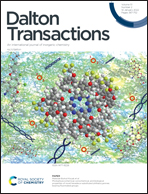The role of anionic heterovalent [PO4]3− → [GeO4]4− substitution on the luminescence properties of inorganic phosphors with the β-Ca3(PO4)2-type structure: new data based on accurate crystal structure refinement†
Abstract
A series of solid-solution phosphate germanates Ca8+0.5xZnEu(PO4)7−x(GeO4)x (x = 0, 0.2, 0, 4, 0.6, 0.8, 1) with the β-Ca3(PO4)2-type structure were synthesized by solid-state reactions. The limit of existence of a single-phase solid solution was determined by X-ray diffraction patterns and it was found at x = 0.8. The heterovalent tetrahedral [PO4]3− → [GeO4]4− substitution requires a charge compensation according to the scheme: [PO4]3− + ½ □ → [GeO4]4− + ½ Ca2+. The additional amount of Ca2+ ions in the crystal structure was detected at the M4 site during Rietveld refinement. It was shown that in β-Ca3(PO4)2-type compounds, charge balancing is not provided by the randomly distributed oxygen vacancies but only by the partial occupancy of the M4 site. The presence of Ca2+ at the M4 site leads to a polar structure with the space group R3c which was confirmed by an SHG test for all single-phase samples. It was shown that the Ge4+ ions preferably occupy the T3 site in the structure, which is connected through common oxygen with the cationic M1–M5 sites. The analysis of the similarity of the previously reported Ca9La(GeO4)0.75(PO4)6 compound reveals an unexpectedly high value. The same structural similarity evaluation of the studied compound Ca8.1EuZn(PO4)6.8(GeO4)0.2 in the present work with the initial model gives a very small value, which indicates a good match between the initial and under-consideration structures. The luminescence properties of Eu3+ were investigated from the point of view of crystal structures and anionic substitutions. The integral intensity increased linearly with the [PO4]3− → [GeO4]4− substitution. It can be concluded that the anionic substitution on Ge4+ can improve the luminescence characteristics. The present study includes new data on the anionic substitution based on accurate crystal structure refinement.
![Graphical abstract: The role of anionic heterovalent [PO4]3− → [GeO4]4− substitution on the luminescence properties of inorganic phosphors with the β-Ca3(PO4)2-type structure: new data based on accurate crystal structure refinement](/en/Image/Get?imageInfo.ImageType=GA&imageInfo.ImageIdentifier.ManuscriptID=D1DT03534G&imageInfo.ImageIdentifier.Year=2022)


 Please wait while we load your content...
Please wait while we load your content...